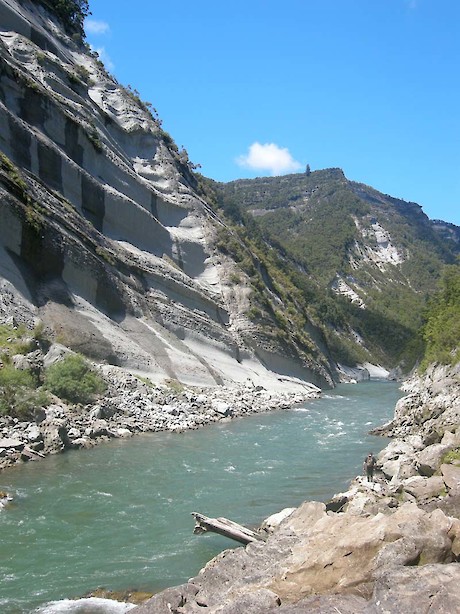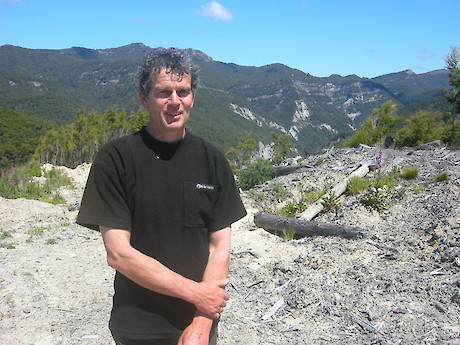Remarkable New Discoveries of Kakabeak
In November 2010, Pete Shaw, working for Simon Hall under the auspices of the Forest Life Force Restoration Trust, discovered three previously unrecorded plants of Clianthus maximus (kakabeak or ngutukaka) beside the Mohaka River. He found them by hiking upstream during the flowering season, near the village of Kotemaori, and spent several hours scanning the cliffs above the river that were inaccessible to goats.

 Kakabeak is commonly found in gardens but, with fewer than 120 individual plants now known from the wild, it is one of New Zealand’s most threatened species. That makes these recent discoveries all the more important for conservation of the species. Also occurring in the river valley on the rocky outcrops were the rare native plants Pimelea longifolia and Scandia rosifolia and a meadow of Mexican daisy—an exotic weed—growing in the river gravels.
Kakabeak is commonly found in gardens but, with fewer than 120 individual plants now known from the wild, it is one of New Zealand’s most threatened species. That makes these recent discoveries all the more important for conservation of the species. Also occurring in the river valley on the rocky outcrops were the rare native plants Pimelea longifolia and Scandia rosifolia and a meadow of Mexican daisy—an exotic weed—growing in the river gravels.
In December 2010, the Mohaka plants were revisited in an RNZAF Iroquois in an attempt to recover plant material for propagation. Gareth Boyt of the Department of Conservation’s Rangataiki Area Office was carried on the end of a 60 m winch cable. As well as retrieving material from two plants for propagation at a nursery in Napier, Gareth also spotted yet another kakabeak close to the others bringing the number of new plants found in the Mohaka in 2010 to four.
To date, seven kakabeak have been found by the Trust team, four on bluffs near the Mohaka River and another three on bluffs near the Waiau River, Hawke’s Bay. In addition, another plant was refound near the Waiau River in 2008 by Willie Shaw and Pete Shaw following up on Willie’s initial discovery of a plant there 1983. Currently, 48 seedlings sourced from the Waiau plants are planted out in a purpose-built enclosure at Simon Hall’s Maungataniwha Native Forest property, with another 150 plants under propagation at nurseries in Napier.
The Forest Life Force Restoration Trust has also gathered seed over two seasons from Pittosporum turneri at Pohokura, near the Napier-Taupo Highway. The seed have been propagated at the Taupo Native Plant Nursery and, currently, over 10,000 seedlings are under propagation there. This has been a direct result from intensive possum control work undertaken at Pohokura.
As well as this significant plant species recovery work, the Trust has initiated a kiwi restoration project at Simon Hall’s Maungataniwha Native Forest property and, after four seasons, this project has returned 36 kiwi chicks to the Cape Kidnappers and Ocean Beach Wildlife Preserve, along with 35 kiwi chicks released back into the wild at the Maungataniwha Native Forest.
Clianthus maximus.
Posted: 26/04/2011
